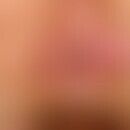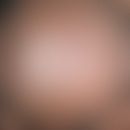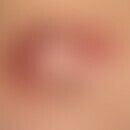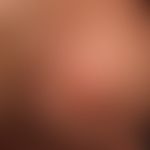Synonym(s)
DefinitionThis section has been translated automatically.
Inflammatory maximum variant of tina capitis, accompanied by abscess-like, with furunculoid granulomas. Primarily caused by animal pathogenic (zoophilic) dermatophytes. S.u. Tinea. The disease is often misdiagnosed, so that the clientele often consists of insufficiently pretreated cases.
PathogenThis section has been translated automatically.
You might also be interested in
ManifestationThis section has been translated automatically.
ClinicThis section has been translated automatically.
Itchy or moderately painful, 0.5-5.0 cm large, usually well defined, cushion-like raised, purulent, highly red inflammatory plaques or nodules. The inflammatory nodules are often interspersed with follicular pustules. A confluence of pustules is rarer. Pus can be emptied under pressure. Hairs are missing in the lesion or exist only sparsely. Hairs that still exist can be easily and usually painlessly extracted (preparation of a native preparation for fungal detection).
DiagnosisThis section has been translated automatically.
Differential diagnosisThis section has been translated automatically.
- Alopecia areata: No itching, no signs of inflammation, no scaling of the surface.
- Furuncle: Highly painful, acute onset; originating from a follicle; no multiple pustules on the surface, distinctly fluctuant.
- Folliculitis decalvans: Eminently chronic course, usually lasting years; scarring alopecia. Highly red skin lesions with usually atrophic shiny center. Marginal follicular papules, later pustular transformation and crusting. Irregularly shaped scar foci with small-spotted, irreversible hair loss result. Formation of tufted hair.
- Folliculitis sclerotisans nuchae: occurring almost exclusively in black males; usually localized to the nape of the neck. Hard, dark red, hemispherical, shiny nodules of varying size, pierced by terminal or vellus hairs, which may confluence. Furthermore, bulging, sclerotic induration of the intervening skin.
External therapyThis section has been translated automatically.
As a first step, a local shave is recommended as well as a consistent local treatment with griseofulvin cream(e.g. Gricin) or topical broad-spectrum antifungals such as amorolfin cream(Loceryl), ketoconazole cream(e.g.Nizoral), terbinafine cream(e.g. Lamisil), Ciclopirox ointment(e.g. Batrafen), Clotrimazole ointment(e.g. Canesten) or bifonazole cream(e.g. Mycospor). The externals should be applied to the inflammatory lesion as thick as the back of a knife. Then cover with a gauze compress and fix with a tubular bandage. The dressing is changed daily (if necessary 2 times/day). The ointment residues can be carefully absorbed with olive oil. Hair washing with a mild syndet (e.g. Dermowas) is possible.
Internal therapyThis section has been translated automatically.
Absolutely necessary. Systemic antimycotics are recommended over a period of 8-12 weeks, at best 10-14 days beyond the clinical healing stage. S.u. Tinea capitis.
Progression/forecastThis section has been translated automatically.
Note(s)This section has been translated automatically.
LiteratureThis section has been translated automatically.
- Nenoff P et al (2014) Mycology - An Update Part 2: Dermatomycoses: Clinical picture and diagnostics. YYG 12: 749-778
Incoming links (10)
Acne keloidalis nuchae; Boils; Celsus kerion; Herxheimer reaction; Kerion celsi; Tinea capitis (overview); Trichophytia capillitii; Trichophytia profunda; Trichophyton mentagrophytes; Trichophyton verrucosum;Outgoing links (16)
Acne keloidalis nuchae; Alopecia areata (overview); Amorolfin; Antimycotics; Bifonazole; Boils; Ciclopirox; Clotrimazole; Dermatophytes; Folliculitis decalvans; ... Show allDisclaimer
Please ask your physician for a reliable diagnosis. This website is only meant as a reference.










